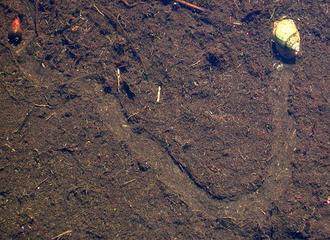
Adaptation
"I'm not going anywhere!"
Most terrestrial snails tend to be sedentary but occasionally move to feed or reproduce. There may be short distance dispersal of Vertigo morsei over a large period of time under favorable environmental conditions.
Long distance migration can occur in several ways, but this isn't normal activity. Other terrestrial mammals, birds, or insects will carry the snails to a different location if the snail becomes attached to their body or is picked up in their food and later dropped in transport. Snails may also happen to flow downstream on a floating object such as a log.
Scattering of snail populations can happen from human activities as well like during transport of food or from efforts to control invasive species. (Cordeiro 2010)
To get around on their own, snails need enough water, as mentioned on the Habitat page, because these organisms continuously create mucous trails. These traces are good ways to identify the path of a snail or slug. When dried, the slime becomes flaky and appears white.
As a member of the order Stylommatophora, Vertigo morsei possesses a pair of tentacles with eyes attached at the tips. These eyes aren't developed like our human ones; however, they help distinguish light and dark in their environment. (Burch 1962)
The dark brown shell of the Six-whorl Vertigo also has helped this and other snails live in a terrestrial habitat because its color aids in blending in to the surroundings.
Moisture, temperature, and light intensity limit the activity of any land snail, including Vertigo morsei. Snails are commonly nocturnal but may be seen during the day after a rain or if it is humid outside. They need to limit the amount of water loss because it is vital for reproduction and physiological activity inside the body. (Vertigo morsei Sterki 2009)
Check out NatureServe Explorer for more coverage on Vertigo morsei and many other organisms!
Also explore Animal Diversity Web hosted by the University of Michigan Museum of Zoology!
What do they eat and how? ...Nutrition
